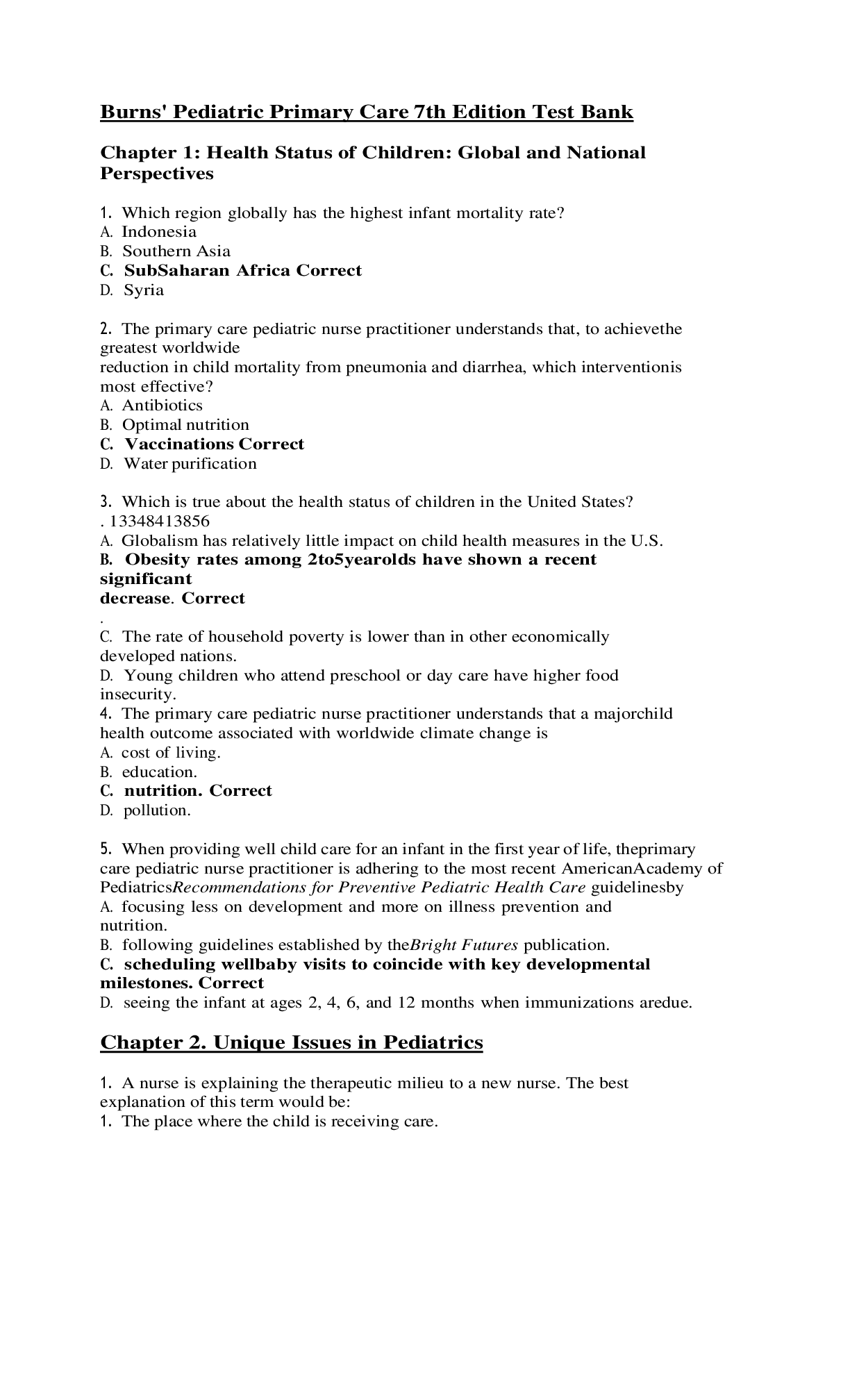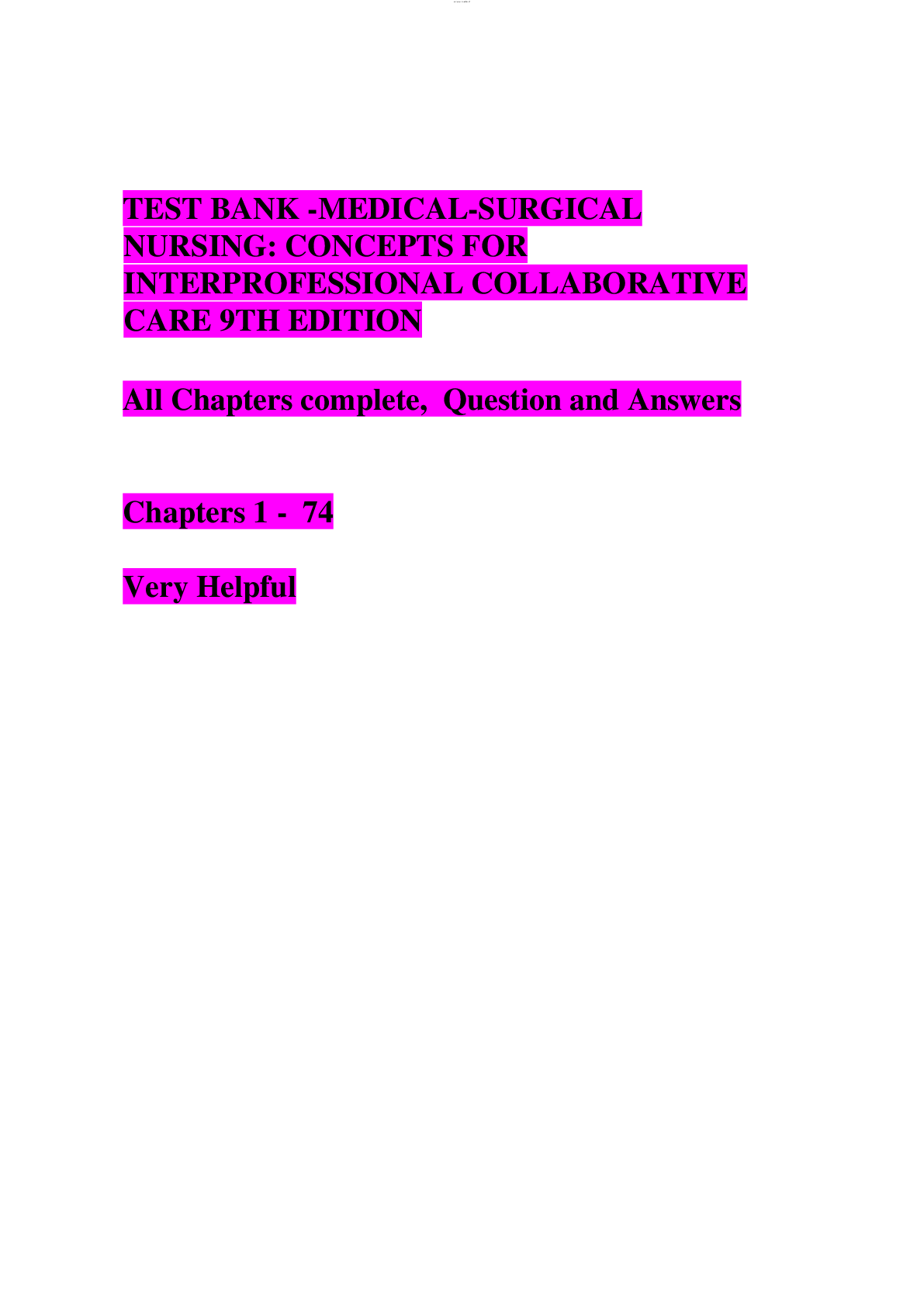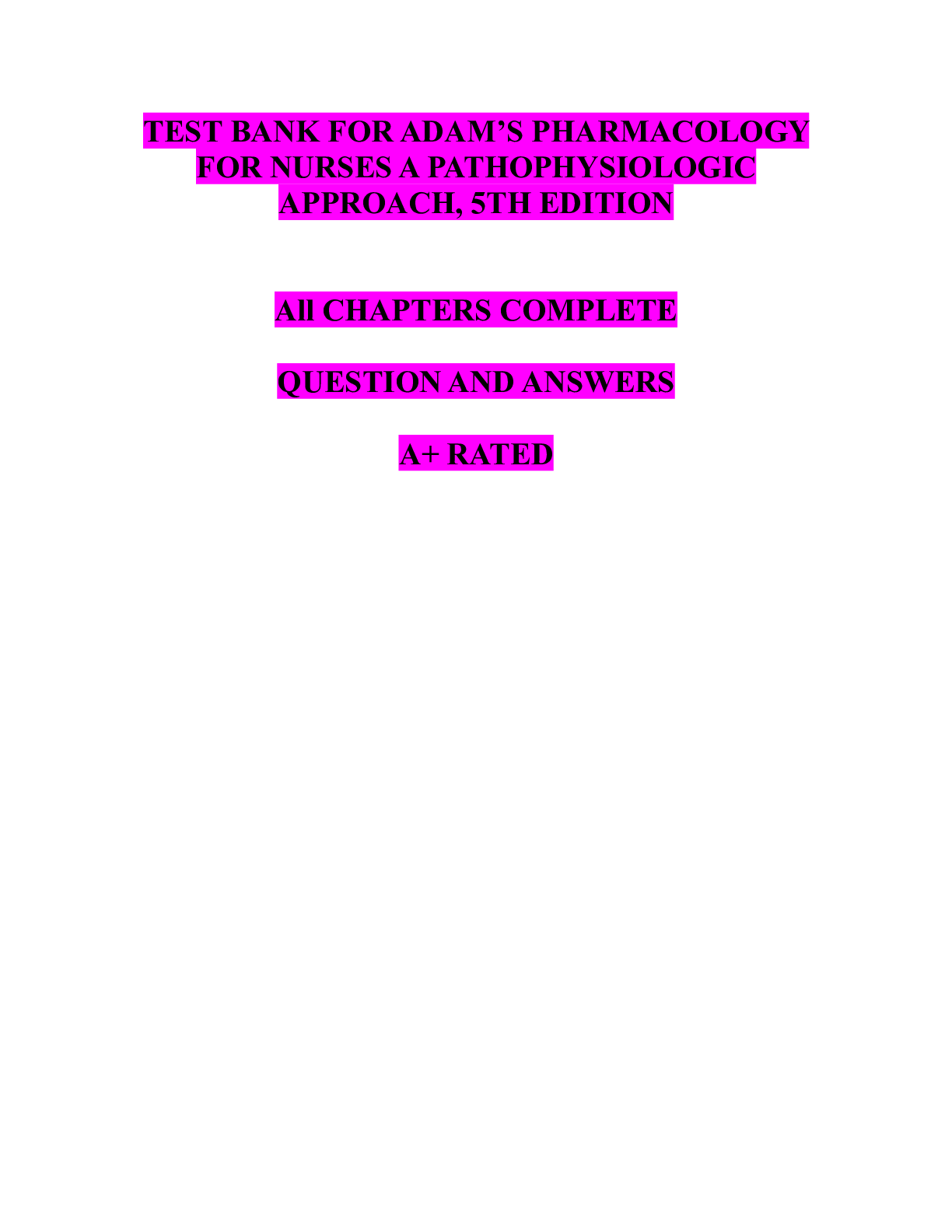Financial Accounting > TEST BANK > Advanced Accounting Theories Test Bank Question And Answers (100% CORRECT) (All)
Advanced Accounting Theories Test Bank Question And Answers (100% CORRECT)
Document Content and Description Below
pter 6 1. Which of the following does not describe the accounting system of affair? a. The emphasis is on asset net realizable value, not historical cost b. the statement of affair is concerned onl... y with the assets of the debtor organization, not the claims c. the statement can also be used in reorganization d. the statement of affair is based on estimated values; actual realized values may be different Answer: B The statement of affair is an important planning report for the anticipated liquidation of the company. Thus historical cost figures are not relevant. The various parties concerned desire information that reflects (1) net realizable value of the debtor’s assets and the (2) ultimate application of these proceeds to specific liabilities. CPA reviewer Advance Accounting 2019-Dayag Theories 2-7 2. A corporation’s accounting statement of affairs shows a dividend of 115%. The dividend means that: a. Secured creditors will received an amount in excess of the book value of their claims. b. Unsecured creditors will receive an amount in excess of the book value of their claims. c. Stockholders may expect some return on their interest d. An error was made in the preparation of the statement. Answer: C The statement implies that Stockholders may expect some return on their interest. CPA reviewer Advance Accounting 2019-Dayag Theories 2-11 3. Which statement is false concerning the statement of affairs? a. Total unsecured liabilities do not include unsecured debts with priority. b. Unsecured liabilities consist of debts for which no asset are pledged as security, as well as debts in excess of the liquidation value of assets pledged. c. Net free assets are the excess of liquidation value of assets pledged to fully secured creditors over the amount of fully secured liabilities plus free assets less unsecured liabilities with priority. d. The estimated deficiency to unsecured creditors is total unsecured liabilities less total free assets. Answer: D The estimated deficiency is computed as Net free assets less Total unsecured liabilities. CPA reviewer Advance Accounting 2019-Dayag Theories 2- 4 4. Which of the following would appear on a statement of realization and liquidation? a. net realizable value of asset pledged to partially secured creditors b. estimated deficiency to unsecured creditors c. net realizable value of assets to be realized d. gain or loss on realization Answer: D The statement of Realization and Liquidation is a document used by the trustee to report periodically on the status of fiduciary activities. During the realization, gain or losses on assets sales may occur, expenses may incurred, and revenues may be earned. CPA reviewer Advance Accounting 2019-Dayag Theories 2-15 5. The Statement of Realization and liquidation differs from Statement of affairs because a. The statement of realization and Affairs reports estimated realizable values rather than actual liquidation result. b. The statement of realization and Affairs is a summary of secured debt activity only c. The statement of realization and Affairs prepared only at a final completion of the liquidation process d. The statement of realization and Affairs reports actual liquidation results rather than estimated realizable values Answer: D Statement of Affairs is a document used to estimate amounts available to each class of claim while Statement of Realization and Liquidation is a document that shows the actual liquidation of a corporation in which gain or losses in realization may occur. CPA reviewer Advance Accounting 2019-Dayag Theories 2- 17 6. A corporation that is unable to pay its debts as they become due is: a. bankrupt. b. overdrawn. c. insolvent. d. liquidating. Answer: B Advance Accounting by Jeter and Chaney 3rd Edition - Test Bank 7. When a business becomes insolvent, it generally has three possible courses of action. Which of the following is not one of the three possible courses of action? a. The debtor and its creditors may enter into a contractual agreement, outside of formal bankruptcy proceedings. b. The debtor continues operating the business in the normal course of the day-to-day operations. c. The debtor or its creditors may file a bankruptcy petition, after which the debtor is liquidated. d. The debtor or its creditors may file a petition for reorganization. Answer: C Advance Accounting by Jeter and Chaney 3rd Edition - Test Bank 8. A Statement of Affairs is a report designed to show: a. an estimated amount that would be received by each class of creditor’s claims in the event of liquidation. b. a balance sheet prepared on the going-concern assumption. c. assets and liabilities classified as current and noncurrent. d. assets and liabilities reported at their current book values. Answer: A Advance Accounting by Jeter and Chaney 3rd Edition - Test Bank 9. When a secured claim is not fully settled by the selling of the underlying collateral, the remaining portion: a. of the claim cannot be collected by the creditor. b. remains as a secured claim. c. is classified as an unsecured priority claim. d. is classified as an unsecured nonpriority claim. Answer: B Advance Accounting by Jeter and Chaney 3rd Edition - Test Bank 10. The duties of the trustee include: a. appointing creditors’ committees in liquidation cases. b. approving all payments for debts incurred before the bankruptcy filing. c. examining claims and disallowing any that are improper. d. calling a meeting of the debtor’s creditors. Answer: C Advance Accounting by Jeter and Chaney 3rd Edition - Test Bank Chapter 8 1. According to the installment method of accounting, gross profit on an installment basis is recognize as income a. on the date of sale b. on the date the final collection is received c. in proportion to the cash collection d. after cash collection equal to the cost of sales have been received Answer: C When receivables are collected over an extended period and no reasonable basis exists for estimating the degree of collectibility, the installment method may be used. Under the installment method, gross profit recognize during each period of the term of an installment receivable is equal to the gross profit ratio on the installment sales for the period in which receivable was recognized, multiplied by the cash collected on that receivable during the [period. Hence, gross profit is recognized in proportion to the cash collection received. Comprehensive reviewer and test bank in Practical accounting 2 by Hilario Tan 2. When assets that have been sold and accounted for by the installment method are subsequently repossessed and return to the inventory, they should be recorded on the books at a. Selling price b. The amount of the installment receivable less associated deferred gross profit c. Net realizable value d. Net realizable value minus normal profit Answer: D Repossessed assets returned to the inventory should usually be recorded at their net realizable value minus normal profit. Net realizable value is the selling price minus cost of completion, reconditioning and reselling. Sales profit should be recognized upon resale. Comprehensive reviewer and test bank in Practical accounting 2 by Hilario Tan 3. Using the cost-recovery method of revenue recognition, profit on an installment sale is recognized a. On the date of the installment sales b. In proportion to the cash collections c. After collections equal to the cost of goods sold have been received d. On the date the final cash collection is received. Answer C Under the cost-recovery method, no revenue is recognized until cash payments by the buyer exceed the seller’s cost of the merchandise sold. This method is appropriate when collection of the revenue is certain. Comprehensive reviewer and test bank in Practical accounting 2 by Hilario Tan 4. Lyris Co. Records all sales using installment method of accounting. Installment sales contracts call for 36 equal monthly cash payments. The amount of deferred gross profit relating to collections of 12 months beyond the balance sheet date should be reported in the a. Current liability section as a deferred revenue b. Noncurrent liability section as a deferred revenue c. Current asset section as a contra account d. Noncurrent asset section as a contra account Answer: D Under the installment method, a credit sale is recorded by debiting a receivable and crediting inventory and deferred gross profit. Revenue is recognized only when cash is collected. Because of the essence of an installment sale is an equal change in receivable and inventory, the deferred gross profit account serves to reduce the asset valuation to the unrecovered cost of goods sold. Accordingly, deferred gross profit function as an asset valuation (contra account). The installment receivables should be classified in the current section of the balance sheet if they are collectible within the operating cycle. All of the Lyris Co installment sales contract are for 36 mos. They are apparently related to the normal operations and should be classified as current. Comprehensive reviewer and test bank in Practical accounting 2 by Hilario Tan 5. Christian Co. sells equipment on installment contracts. Which of the following justifies Christian use of costrecovery method of revenue recognition to account for these installment sales? a. The sale contract provides that title to the equipment only passes to the purchaser when all payments have been made b. No cash payment are due until one year from the date of sale c. Sales are subject to a high rate of return d. There is no reasonable basis for estimating collectibility Answer: D APB 10 states that revenues ordinarily should be accounted for when transaction is completed, with appropriate provision for uncollectible accounts. However, when “there is no reasonable basis for estimating the degree of uncollectibility” either the installment or cost recovery method may be used. The cost-recovery method recognizes profit only after collections exceeds the cost of the item sold Comprehensive reviewer and test bank in Practical accounting 2 by Hilario Tan 6. An acceptable method for recognizing profit when the collection of cash is in doubt is the a. Percentage-of-completion method. b. Installment method. c. Completed-contract method. d. Consignment method. CMA 0685 4-35 Answer: B REQUIRED: the method of recognizing profit. DISCUSSION: (B) Revenue is to be recognized when it is realized or realizable and earned. If no reasonable basis exists for estimating the degree of collectibility of assets to be received for products, services, or other assets, revenues and gains may be recognized on the basis of cash received. Thus, the installment method or the cost recovery method may be used (APB10). Answers (A), (C), and (D) are incorrect because they are not acceptable methods for recognizing profit when the collection of cash is in doubt. Comprehensive Reviewer and Test Bank in Practical Accounting 2 by Hilario G. Tan 7. For financial statement purposes, the installment method of accounting may be used if the a. Collection period extends over more than 12 months. b. Installments are due in different years. c. Ultimate amount collectible is indeterminate. d. Percentage-of-completion method is inappropriate. AICPA 1191 T-6 Answer: C REQUIRED: The use of the installment method. DISCUSSION: APB 10, Omnibus Opinion – 1966, reaffirms that profits from sales in the ordinary course of business should usually be recognized at the time of sale unless collection of the sales price is not reasonably assured. When receivables are collected over an extended period and, because of the terms of the transaction or other conditions, no reasonable basis exists for estimating the degree of collectibility, the installment method or thecostrecovery method of accounting may be used. Answers (A) and (B) are incorrect because, regardless of the length of the collection period, sales in the ordinary course of business should usually be recognized at the time of sale unless collectibility is not reasonably assured. Answer (D) is incorrect because the installment method, which is ordinarily used to account for long-term construction contracts. Comprehensive Reviewer and Test Bank in Practical Accounting 2 by Hilario G. Tan 8. To properly account for an installment sale, all of the following must be readily determinable except A. The amount of gross profit to be deferred. B. The total cash collected on each year's sales. C. The operating costs to be deferred. D. Costs associated with default and repossession. CMA 1292 2-20 Answer: C Answer (C) is correct. The accounting treatment of installment sales recognizes gross profit as cash is received. Gross profit is deferred at the time of sale and recognized as income in the accounting periods in which cash is received. Thus, the accountant must know the amount of gross profit to be deferred, the cash collected each year, and perhaps the costs associated with default and repossession. When goods are repossessed, they are returned to inventory at net realizable value (selling price - costs of completion, reconditioning, and selling) minus normal profit. The interest costs on the funds tied up in receivables are also a consideration. However, no operating costs are deferred as a result of installment sales.Answer (A) is incorrect because the amount of gross profit to be deferred must be known to allocate it over future periods. Answer (B) is incorrect because the amount of cash collected each year is used to allocate gross profit to the proper periods. Answer (D) is incorrect because default and repossession often occur as a result of installment sales. Comprehensive Reviewer and Test Bank in Practical Accounting 2 by Hilario G. Tan 9. If sales are accounted for using the installment method, which of the following is (are) only recognized in proportion to the cash collected on the sales during the period? A. Sales. B. Sales and cost of sales. C. Sales and cost of sales and selling expenses. D. Sales and cost of sales and administrative expenses. CIA 0595 IV-11 Answer: B Answer (B) is correct. Under the installment method, the gross profit on sales (sales - cost of sales) is not recognized until cash is collected. The proportion of cash collected on the sales during the accounting period determines the proportion of the gross profit on those sales that is recognized during the period. Hence, both sales and cost of sales are deferred. Answer (A) is incorrect because sales and cost of sales are recognized in proportion to cash collections. Answer (C) is incorrect because only the gross profit (sales - cost of sales) is deferred on sales for which cash has not yet been collected. Answer (D) is incorrect because only the gross profit (sales - cost of sales) is deferred on sales for which cash has not yet been collected. Comprehensive Reviewer and Test Bank in Practical Accounting 2 by Hilario G. Tan 10. Pie Co. uses the installment sales method to recognize revenue. Customers pay the installment notes in 24 equal monthly amounts, which include 12% interest. What is an installment note’s receivable balance six months after the sale? a.75% of the original sales price. b. Less than 75% of the original sales price. AICPA 1192T-9 c. The present value of the remaining monthly payments discounted at 12%. d. Less than the present value of the remaining monthly payments discounted at 12%. Answer: C REQUIRED: The balance of an installment note 6 month after sale. DISCUSSION: (C) The balance of an installment note receivable equals the unpaid principal. The difference between the gross receivable and the unpaid principal equals interest. Thus, the balance of the note is equal to the present value of the remaining payments discounted at the contract interest rate. Answers (A) and (B) are incorrect because the balance will be greater than 75% of the price. Because early payments contain a greater interest component than later payments, the sum of the principal components of the first six payments will be less than 25% of the price. Answer (D) is incorrect because the principal balance equals the present value of the remaining payments. Comprehensive Reviewer and Test Bank in Practical Accounting 2 by Hilario G. Tan Chapter 9 1. Which of the following is true about accounting for long-term construction contract? a. Contract assets are likely to be larger if revenue is recognized over time rather than if revenue is recognized at the point in time. b. Contract assets are likely to be smaller if revenue is recognized over time rather than if revenue is recognized at the point in time. c. Contract assets are likely to be the same size regardless of whether revenue is recognized over time or at a point in time. d. There is no way to tell how revenue recognition timing will affect the size of contract assets without more information. Answer: A Construction in progress includes both cost and gross profit (or overall contract loss) when revenue is recognized over time, but only cost (and overall contract loss) when revenue is recognized upon contract completion, so the contract asset is likely to be larger when revenue is recognized over time. CPA reviewer Advance Accounting 2019-Dayag Theories 4-4 2. With respect to delaying revenue recognition until completion of a long- term contract, it is the case that: a. Estimated losses on the overall contract are recognized before the contract is completed. b. Expenses are recognized each period, but revenue is only recognized when the contract is completed. c. Use of this approach is not permitted under generally accepted accounting principles. d. Neither gain nor losses are recognized until contract is completed. Answer: A Even when revenue recognition over time is not appropriate, such that revenue recognition is delayed until they completion of a contract, estimated losses on the overall contract are recognized in the period in which the company realizes that those losses became evident. CPA reviewer Advance Accounting 2019-Dayag Theories 4-8 3. When accounting for revenue over time for a long term contract, the percentage of completion used to recognize revenue in the first year usually is determined by measuring: a. Costs incurred in the first year, divided by estimated remaining cost to complete the project. b. Costs incurred in the first year, divided by estimated total cost for the completed project. c. Costs incurred in the first year, divided by estimated gross profit. d. Costs incurred in the first year, divided by estimated total cost to be incurred in the remaining years of the project. Answer: B Use of a “cost-to- cost” ratio to estimate percentage of completion is typical. CPA reviewer Advance Accounting 2019-Dayag Theories 4-9 4. A rationale for recognizing revenue over the life of a contract rather than of a single point in time is that: a. Results are more conservative b. It provides a better measure of periodic accomplishment. c. It is a better match with legal ownership. d. It results in a lower income tax. Answer: B Recognizing revenue over time conveys the benefit to the company of satisfying performance obligation over time. CPA reviewer Advance Accounting 2019-Dayag Theories 4-6 5. Which of the following is not true about accounting for long- term construction contract? a. Long- term construction contracts could show a contract asset or contract liability, depending on the relation between construction in progress and billings. b. Billings on contracts in progress is a contra account to accounts receivable. c. Gross profit is debited to construction in progress. d. when a customer is billed for payment due, billings on contracts in progress is credited at the same time accounts receivable is debited. Answer: B Billings is contra to Construction in progress, not Accounts receivable CPA reviewer Advance Accounting 2019-Dayag Theories 4-12 6. The percentage-of-completion method of accounting for long-term construction contracts is an exception to the CMA 1296 2-10 A. Matching principle. B. Going-concern assumption. C. Economic-entity assumption D. Revenue recognition principle. Answer: D Answer (D) is correct. The revenue recognition principle states that revenue should be recognized (recorded) when realized or realizable and earned. Revenue is earned when the earning process is essentially complete. In effect, revenue is recorded when the most important event in the earning of that revenue has occurred. Thus, revenue is normally recorded at the time of the sale or, occasionally, at the time cash is collected. However, sometimes neither the sales basis nor the cash basis is appropriate, such as when a construction contract extends over several accounting periods. As a result, contractor ordinarily recognize revenue using the percentage-of-completion method so that some revenue is recognized each year over the life of the contract. Hence, this method is an exception to the general principle of revenue recognition, primarily because it better match revenues and expenses. Answer (A) is incorrect because the percentage-of-completion method attempts to match revenues and expenses with the appropriate periods. Answer (B) is incorrect because the going-concern assumption is appropriate for a contractor using the percentage-of-completion method, as for any other type of company. Answer (C) is incorrect because the economic-entity assumption is appropriate for a contractor using the percentage-of-completion method, as for any other type of company. Comprehensive Reviewer and Test Bank in Practical Accounting 2 by Hilario G. Tan 7. The percentage-of-completion method of accounting for long-term construction contracts is an exception to the A. Matching principle. CMA 0691 2-15 B. Going concern assumption. C. Historical cost principle. D. Revenue recognition principle. Answer: D Answer (D) is correct. Revenue is recognized when realized or realizable and the earning process is substantially complete. This ordinarily occurs at the time of sale and delivery of goods or services. Thus, the percentage-of-completion method is essentially an exception to the revenue recognition principle. Production rather than sale and delivery is considered to be the culmination of the earning process. Answer (A) is incorrect because the percentage-of-completion method attempts a more accurate association of cost incurrence and revenue recognition. Answer (B) is incorrect because the percentage-ofcompletion method is completely consistent with the going concern assumption. Answer (C) is incorrect because the percentage-of-completion method is completely consistent with the historical cost principle. Comprehensive Reviewer and Test Bank in Practical Accounting 2 by Hilario G. Tan 8. Although a transfer of ownership has not occurred, the percentage-of-completion method is acceptable under the revenue recognition principle because A. The assets are readily convertible into cash. B. The production process can be readily divided into definite stages. C. Cash has been received from the customer. D. The earning process is completed at various stages. CMA 1292 2-17 Answer: D Answer (D) is correct. SFAC 5 states that revenue should be recognized when it is both realized or realizable and earned. If a project is contracted for before production and covers a long time period in relation to reporting periods, revenues may be recognized by a percentage- of-completion method as they are earned (as production occurs), provided reasonable estimates of results at completion and reliable measures of progress are available. Thus, contractors traditionally use the percentage-of-completion method because some revenue can be recognized during each period of the production process. In a sense, the earning process is completed in various stages; thus, revenues should be recorded in each stage. Answer (A) is incorrect because, depending upon the terms of the contract, the assets may not be readily convertible into cash. Answer (B) is incorrect because, on a large construction project, the production process often cannot be easily divided into definite stages. Answer (C) is incorrect because cash is sometimes not received until the project is completed. Comprehensive Reviewer and Test Bank in Practical Accounting 2 by Hilario G. Tan 9. A building contractor has a fixed-price contract to construct a large building. It is estimated that the building will take 2 years to complete. Progress billings will be sent to the customer at quarterly intervals. Which of the following describes the preferable point for revenue recognition for this contract if the outcome of the contract can be estimated reliably? A. After the contract is signed. B. As progress is made toward completion of the contract. C. As cash is received. D. When the contract is completed. Answer: B Answer (B) is correct. Under the percentage-of-completion method, revenues and expenses are recognized based on the stage of completion at the balance sheet date if the outcome of the contract can be estimated reliably. For a fixed-price contract, the outcome can be estimated reliably if (1) total revenue can be measured reliably, (2) it is probable that the economic benefits of the contract will flow to the enterprise, (3) contract costs to complete and stage of completion can be measured reliably, and (4) contract costs can be clearly identified and measured reliably so that actual and estimated costs can be compared. Answer (A) is incorrect because revenue is not recognized until progress has been made toward completion. Answer (C) is incorrect because the cash basis is inappropriate. An accrual method, that is, the percentage-of-completion method, should be used. Answer (D) is incorrect because the completed-contract method is not a permissible method. Comprehensive Reviewer and Test Bank in Practical Accounting 2 by Hilario G. Tan 10. If the Construction in Progress account has a balance of P1,000,000 while the Progress Billings on Contracts account’s balance is P800,000, how should these accounts be reflected on the balance sheet? a. Construction in Progress will be shown as a current asset. b. Progress Billings on Contracts will be shown as a current liability. RPCPA 0598 c. The difference between the two accounts will be reflected as a current asset. d. The difference between the two accounts will be reflected as a current liability. Answer: C REQUIRED: The item(s) used in computing income in the second year using the percentage-of-completion method. DISCUSSION: (C) The percentage-of-completion method provides for the recognition of income based on the relationship between the costs incurred to date and estimated total costs for the completion of the contract. The amount of income (based on the latest available estimated costs) recognized in the second year of a 4-year contract is calculated as follows: The total anticipated income is multiplied by the ratio of the costs incurred to date to the tota estimated costs, and the product is reduced by previously recognized income. Income previously recognized is therefore used to calculated income to be recognized in the second year. However, progress billings to date have no effect on the amount of income to berecognized in the second year. Answers (A), (B), and (D) are incorrect because income previously recognized is used to calculate the income recognized. Progress billings to date are not. Comprehensive Reviewer and Test Bank in Practical Accounting 2 by Hilario G. Tan Chapter 10 1. Assume that ArgyllTech starts selling TechStop franchises. TrueTech charges franchisees an initial fee in exchange for (a) the exclusive right to operate the only TechStop in a particular area for a five year period, (b) the equipment necessary to distribute and repair ArgyllTech products, and (c) training swrvices to be provided over a two-year period. Similar equipment and training can be purchase elsewhere. How many performance obligations exist in this contract? a. 0 b. 1 c. 2 d. 3 Answer: D The exclusive five-year right to operate the only TechStop in a particular area is distinct because it can be used with other goods or services (furnishing, equipment, products) that the customer could obtain elsewhere. The equipment is distinct because similar equipment is sold separately. The training is distinct because similar training could be acquired elsewhere. ArgyllTech would allocate the initial franchise fee to three separate performance obligations based on their relative stand-alone prices: (1) The right to operate TechStop, (2) equipment, (3) training. CPA reviewer Advance Accounting 2019-Dayag Theories 5-1 2. Which of the following is not true about accounting for revenue from franchise agreements? a. Franchise arrangement often include a performance obligation for a license as well as for delivery of goods and services. b. Franchise arrangement typically include one or more performance obligation for which revenue is recognized at a point in time. c. Franchise arrangement typically include one or more performance obligation for which revenue is recognized over a period in time. d. Franchise arrangement typically include one or more performance obligation because the goods and services included in the arrangements are not separately identifiable. Answer: D Franchise arrangement typically includes multiple performance obligation because the goods and services included in the arrangement are both capable of being distinct and are separately identifiable. CPA reviewer Advance Accounting 2019-Dayag Theories 5-52 3. All of the following are the types of franchise arrangements except for: a. Manufacturer-retailer b. Service sponsor-retailer c. Merchandise-retailer d. Wholesaler-retailer Answer: C There are four types of franchise arrangements that have been evolved these are; a. Manufacturer-retailer b. Service sponsor-retailer c. Wholesaler-retailer d. Manufacturer-wholesaler CPA reviewer Advance Accounting 2019- Dayag 4. All revenue for franchise companies is derived from a. Assistance for site selection and negotiating lease. b. Bookkeeping and advisory services c. Sale of initial franchise and continuing fees d. advertising and promotion Answer: C Under PFRS15 on franchise arrangement, the standards identifies two sources of revenue; 1.Initial franchises and 2. Continuing fees CPA reviewer Advance Accounting 2019-Dayag 5-44 5. Franchise fee should be recognized a. On the date the contract was signed b. On the date the franchise is opened for business c. On the date the franchise fee is paid to franchisor d. When performance obligation are satisfied Answer: D Revenue from franchise fee should be recognized on the consummation of transaction, which occurs when all material services and conditions of the sale have been substantially performed. CPA reviewer Advance Accounting 2019-Dayag 5-45 6. Franchise fees are properly recognized as revenue a. when received in cash. b. when a contractual agreement has been signed. c. after the franchise business has begun operations. d. after the franchiser has substantially performed its service. S, S & S Answer: D Comprehensive Reviewer and Test Bank in Practical Accounting 2 by Hilario G. Tan Some of the initial franchise fee may be allocated to a. continuing franchise fees. b. interest revenue on the future installments. c. options to purchase the franchisee's business. d. all of these may reduce the amount of the initial franchise fee that is recognized as revenue. K, W & W Answer: D Comprehensive Reviewer and Test Bank in Practical Accounting 2 by Hilario G. Tan 7. Occasionally a franchise agreement grants the franchisee the right to make future bargain purchases of equipment or supplies. When recording the initial franchise fee, the franchise should a. increase revenue recognized from the initial franchise fee by the amount of the expected future purchases. b. record a portion of the initial franchise fee as unearned revenue which will increase the selling price when the franchisee subsequently makes the bargain purchases. c. defer recognition of any revenue from the initial franchise fee until the bargain purchases are made. d. None of these. K, W & W Answer: B Comprehensive Reviewer and Test Bank in Practical Accounting 2 by Hilario G. Tan 8. A franchise agreement grants the franchisor an option to purchase the franchisee's business. iIt is probable that the option will be exercised. When recording the initial franchise fee, the franchisor should a. record the entire initial franchise fee as a deferred credit which will reduce the franchisor's investment in the purchased outlet when the option is exercised. b. record the entire initial franchise fee as unearned revenue which will reduce the amount of cash paid when the option is exercised. c. record the portion of the initial franchise fee which is attributable to the bargain purchase option as a reduction of the future amounts receivable from the franchisee. d. None of these. K, W & W Answer: A Comprehensive Reviewer and Test Bank in Practical Accounting 2 by Hilario G. Tan 9. Some of the initial franchise fee may be allocated to a. continuing franchise fees. b. interest revenue on the future installments. c. options to purchase the franchisee's business. d. all of these may reduce the amount of the initial franchise fee that is recognized as revenue. K, W & W Answer: D Comprehensive Reviewer and Test Bank in Practical Accounting 2 by Hilario G. Tan 10. Continuing franchise fees should be recorded by the franchisor a. as revenue when earned and receivable from the franchisee. b. as revenue when received. K, W & W c. in accordance with the accounting procedures specified in the franchise agreement. d. as revenue only after the balance of the initial franchise fee has been collected. Answer: A Comprehensive Reviewer and Test Bank in Practical Accounting 2 by Hilario G. Tan Chapter 11 1. The Home office ledger account in the accounting records of a branch is best described as: a. A revenue account b. An equity account c. A deferred revenue account d. None of the foregoing Answer: B The balance of the investment in branch account shows the extent of the home office’s investment in particular branch. the reciprocal home office account on the books of branch represent the home office’s equity in the branch CPA reviewer Advance Accounting 2019-Dayag 6-28 2. In preparing the financial statement s of the home office and its various branches: a. Nonreciprocal accounts are eliminated but reciprocal accounts are combined b. Both reciprocal and nonreciprocal accounts are eliminated c. Both reciprocal and nonreciprocal accounts are combined d. Reciprocal accounts are eliminated and nonreciprocal are combined Answer: D Combined financial statements of the home office and branch are prepared to show the effects of business transactions of the business entity with outsiders. To achieve this, intercompany transactions must be eliminated. CPA reviewer Advance Accounting 2019-Dayag 6-47 3. A control feature in a decentralized accounting system is: a. The balance in the Investment in branch account must equal the balance in the Home office account b. The balance in the investment in branch account must be equal the balance in the Home office capital account less the branch’s cumulative unremitted profits c. The intracompany accounts are eliminated in preparing combined financial statements. d. The balance in the investment n branch account must equal the balance in the branch income account. Answer: A Investment in branch account must equal the balance in the Home office account CPA reviewer Advance Accounting 2019-Dayag 6-17 4. Income taxes pertaining to branch earnings are usually recorded on the books of the a. Home office b. Branch c. Ignored d. None of the above Answer: A Income tax of the branch is recorded in the home office books CPA reviewer Advance Accounting 2019-Dayag 6-4 5. A debit to Income Summary ledger account and a credit to the Home office account appear in: a. The accounting records of the home office to record the net income of the home office b. The accounting records of the home office to record the net income of the branch c. The accounting records of the branch to record the net income of the branch d. None of the foregoing occurred Answer: C The branch recorded the branch net income CPA reviewer Advance Accounting 2019-Dayag 6-31 6. An enterprise uses a branch accounting system in which it establishes separate formal accounting systems for its home office operations and its branch office operations. Which of the following statements about this arrangement is false? A. The home office account on the books of a branch office represents the equity interest of the home office in the net assets of the branch. B. The branch office account on the books of the hoe office represents the equity interest of the branch office in the net assets of the home office. C. The home office and branch office accounts are reciprocal accounts that must be eliminated in the preparation of the enterprise’s financial statements that are presented in accordance with GAAP. D. Unrealized profit from internal transfers between the home office and a branch must be eliminated in the preparation of the enterprise’s financial statements that are presented in accordance with GAAP. (Gleim) Answer: B REQUIRED: The false statement about branch accounting. DISCUSSION: (B) In branch accounting, the branch office account on the books of the home office represents the investment by the home office in the net assets of the branch, not the branch’s equity in the home office. Answers (A), (C), and (D) are incorrect because each is a true statement about branch accounting. Comprehensive Reviewer and Test Bank in Practical Accounting 2 by Hilario G. Tan 7. VERDI, Inc. has several branches. Goods costing P10,000 were transferred by the head office to Cebu Branch with the latter paying P600 for freight cost. Subsequently, the head office authorized Cebu Branch to transfer the goods to Davao Branch for which the latter was billed for the P10,000 cost of the goods and freight charge of P200 for the transfer. If the head office had shipped the goods directly to Davao Branch, the freight charge would have been P700. The P100 difference in freight cost would be disposed of as follows: a. Considered as savings. c. Charged to Davao Branch. b. Charged to Cebu Branch. d. Charged to the Head Office. (RPCPA 0594) Answer: C REQUIRED: The home office journal entry to reflect merchandise shipments at cost plus mark-up. DISCUSSION: (C) When goods are shipped from a home office to a branch at a transfer price that reflects original cost plus a markup, the branch must record the shipment at the transfer price. The home office most often reflects the shipments to branch at original cost. To maintain a reciprocal relationship between the home office and the branch office accounts, an unrealized profit in branch inventories account reflects the mark-up. Answers (A) and (B) are incorrect because neither reflects the unrealized profit. Answer (A) is incorrect because the branch office should be recorded at $125,000. Answer (B) is incorrect because the shipments to branch should be recorded at original cost of $100,000. Answer (D) is incorrect because it is the work sheet entry necessary to eliminate this intercompany transaction in the preparation of the financial statements. Comprehensive Reviewer and Test Bank in Practical Accounting 2 by Hilario G. Tan 8. Which represents the proper journal entry for a periodic inventory system that should be made on the books of the home office when goods that cost the home office $100,000 tomanufacture are shipped to a branch at a transfer price of $125,000 and the billed price is not recorded in the shipments to branch account? Gleim A. Branch office $100,000 Shipments to branch $100,000 B. Branch office $125,000 Shipments to branch $125,000 C. Branch office $125,000 Shipments to branch $100,000 Unrealized profit 25,000 D. Shipment to branch $100,000 Unrealized profit 25,000 Shipments from home office $125,000 Answer: B REQUIRED: The journal entry on the branch book s to reflect the receipt of merchandise shipments at a transfer price that reflects cost plus a mark-up. DISCUSSION: (B) In a periodic system, when merchandise is received by a branch from the home office, the merchandise should be reflected as a shipment from the home office in the amount of the transfer price, with a corresponding entry to the home office account to indicate the equity of the home office in the net assets of the branch. Answer (A) is incorrect because the shipments should be reflected at the transfer price. Answer (C) is incorrect because the home office equity should be reflected at the transfer price. Answer (D) is incorrect because it is the worksheet entry used to eliminate this intercompany transaction in the preparation of the enterprise’s financial statements. Comprehensive Reviewer and Test Bank in Practical Accounting 2 by Hilario G. Tan 9. Which of the following would explain why the investment in branch account is less than the Home office capital account? a. A cash transfer to the branch is in transit b. A cash transfer to the home office is in transit. c. An inventory shipment to the branch (at cost) is in transit d. A home office has received and deposited a remittance from a branch customer but has not yet notified the branch e. none of the above Answer: D CPA reviewer Advance Accounting 2019-Dayag 6- 18 10. The Shipments to branch ledger account in the accounting records of the home office of a business enterprise? a. Is an asset valuation account b. Indicates that the home office uses the periodic inventory system c. Is adjusted at the end of the accounting period to equal the unrealized profit in the branch’s ending inventories d. Is not displayed in the home office’s separate financial statements. Answer: B CPA reviewer Advance Accounting 2019-Dayag 6-21 Chapter 12 True or False 1. The balance of the Overvaluation of Inventories: Branch ledger account is deducted from the balance of the investment in branch account in the separate balance sheet of the home office. Answer: True 2. If the branch manager are responsible for ordering merchandise from the home office, any excess freight cost incurred as a result of inter-branch shipments are absorb by appropriate branch rather than by the home office. Answer True 3. A home office ships merchandise to its branch at a transfer price greater than cost. When merchandise is resold by the branch to outside entity, the branch profit will be overstated. Answer: False- The branch profit will be understated. 4. Unrealized profits from transactions between a home office and its branch are eliminated in preparing combined financial statement. Answer: True 5. In a combined balance sheet for the home office and branch, the balance of the allowance for overvaluation of inventories: branch ledger account is deducted from the balance of the investment in branch account. Answer: False 6. Argyll, Inc has several branches. Goods costing P10,000 were transferred by the head office to Cebu branch with the latter paying P600 for freight cost. Subsequently, the head office authorized Cebu Branch to transfer the goods to Davao branch for which the latter was billed for the P10,000 cost of the goods and freight charge of P200 for the transfer. If the head office had shipped the goods directly to Davao branch, the freight charge would have been P700. The P100 difference in freight cost would be disposed of as follows: a. Considered as savings b. Charged to Cebu Branch c. Charged to Davao Branch d. Charged to Head Office Answer: D Excess freight should be absorb by the home office and treated as an operating expense Guerrero 2017 7. Which of the following statements is incorrect? a. Freight on goods received by the branch directly from the home office are included in the cost of branch inventory. b. Transfer of merchandise from one branch to another justify the increase of inventory value by the additional freight costs incurred because of the indirect routing. c. Excess freight should be absorb by the home office and treated as an operating expense d. None of the above. Answer: B Transfer of merchandise from one branch to another does not justify the increase of inventory value by the additional freight costs incurred because of the indirect routing. Guerrero 2017 8. If the home office and the branch maintain perpetual inventory system; a. The use of shipments to branch and Shipments from home office is necessary b. Upon receipt of merchandise, the branch debits the Merchandise inventory account and credits the Branch account at billed price c. When sale is made by the branch, the Cost of goods sold account is debited and merchandise inventory account is credited d. All of the above. Answer: C The use of shipments to branch and Shipments from home office is unnecessary. Upon receipt of merchandise, the branch debits the Merchandise inventory account and credits the Home office account at billed price Guerrero, 2017 9. This merchandise shipment account is always at cost. a. Merchandise shipments to Branch b. Merchandise shipments from Home office c. Home Office current account d. Branch current account Answer: A The inventories reported by branch are based on the billed price. Guerrero 2017 10. This nominal account includes the mark up on branch merchandise before adjusting entries are made. a. Merchandise shipments from Home Office b. Home Office Current Account c. Branch Current Acco [Show More]
Last updated: 1 year ago
Preview 1 out of 195 pages

Buy this document to get the full access instantly
Instant Download Access after purchase
Add to cartInstant download
We Accept:

Reviews( 0 )
$15.00
Document information
Connected school, study & course
About the document
Uploaded On
May 24, 2021
Number of pages
195
Written in
Additional information
This document has been written for:
Uploaded
May 24, 2021
Downloads
0
Views
59

.png)
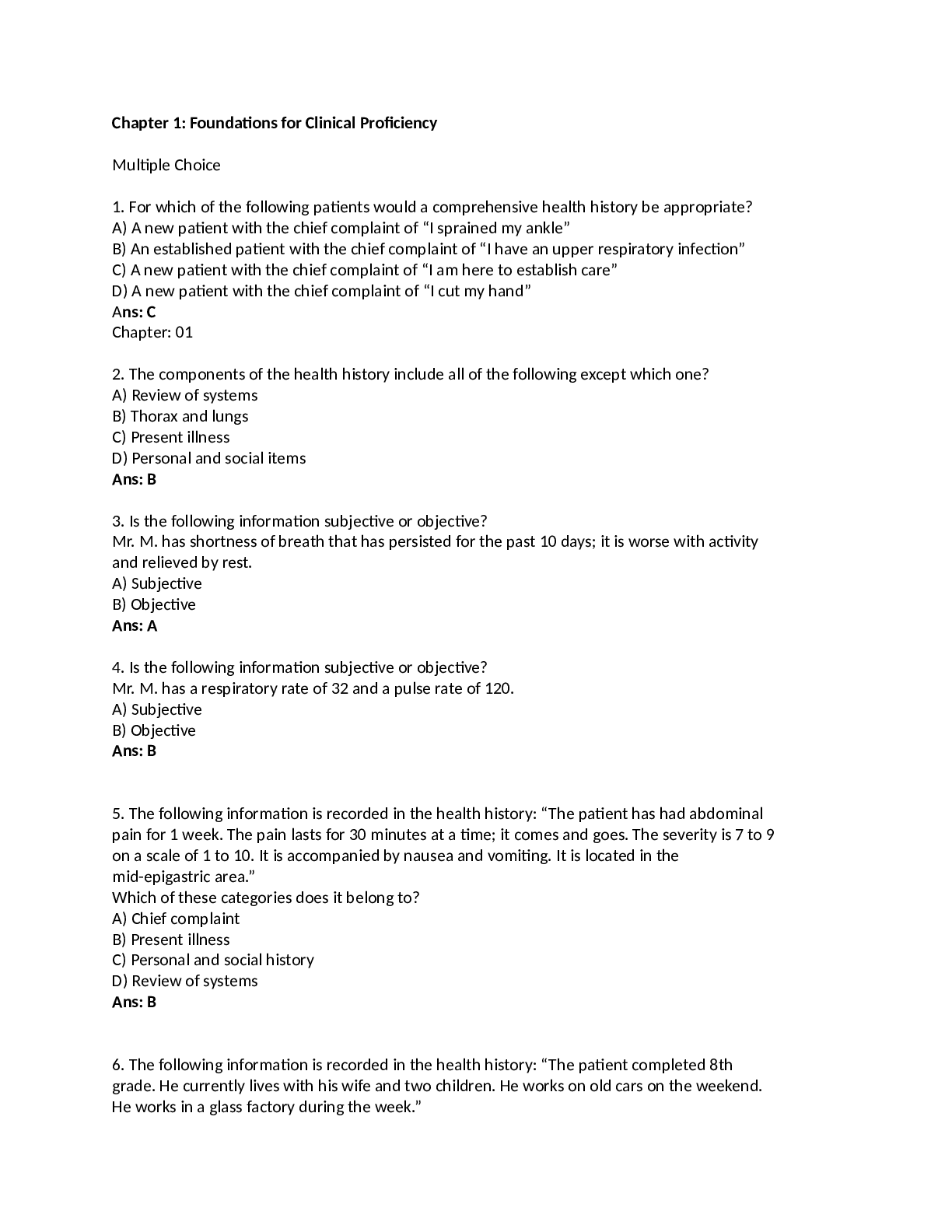

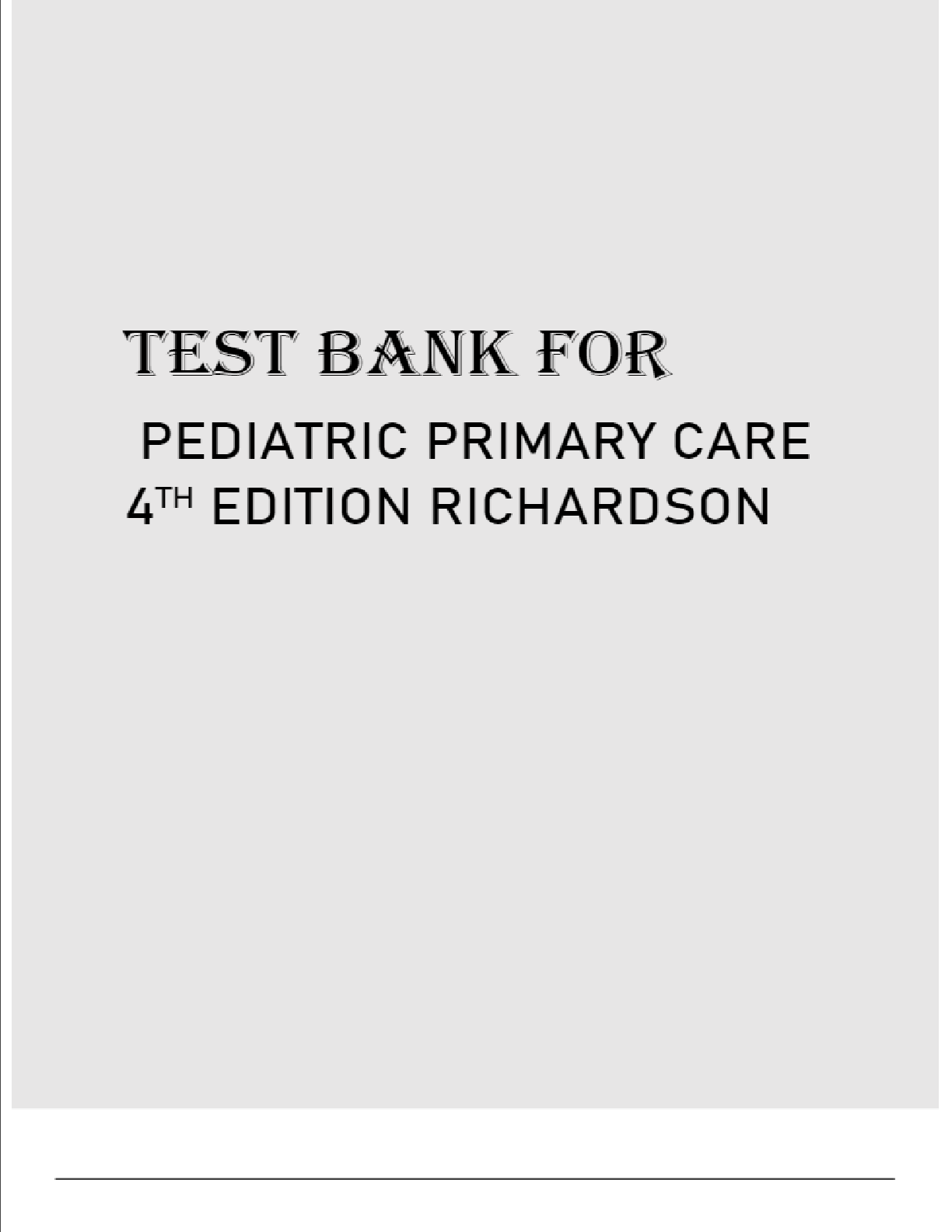





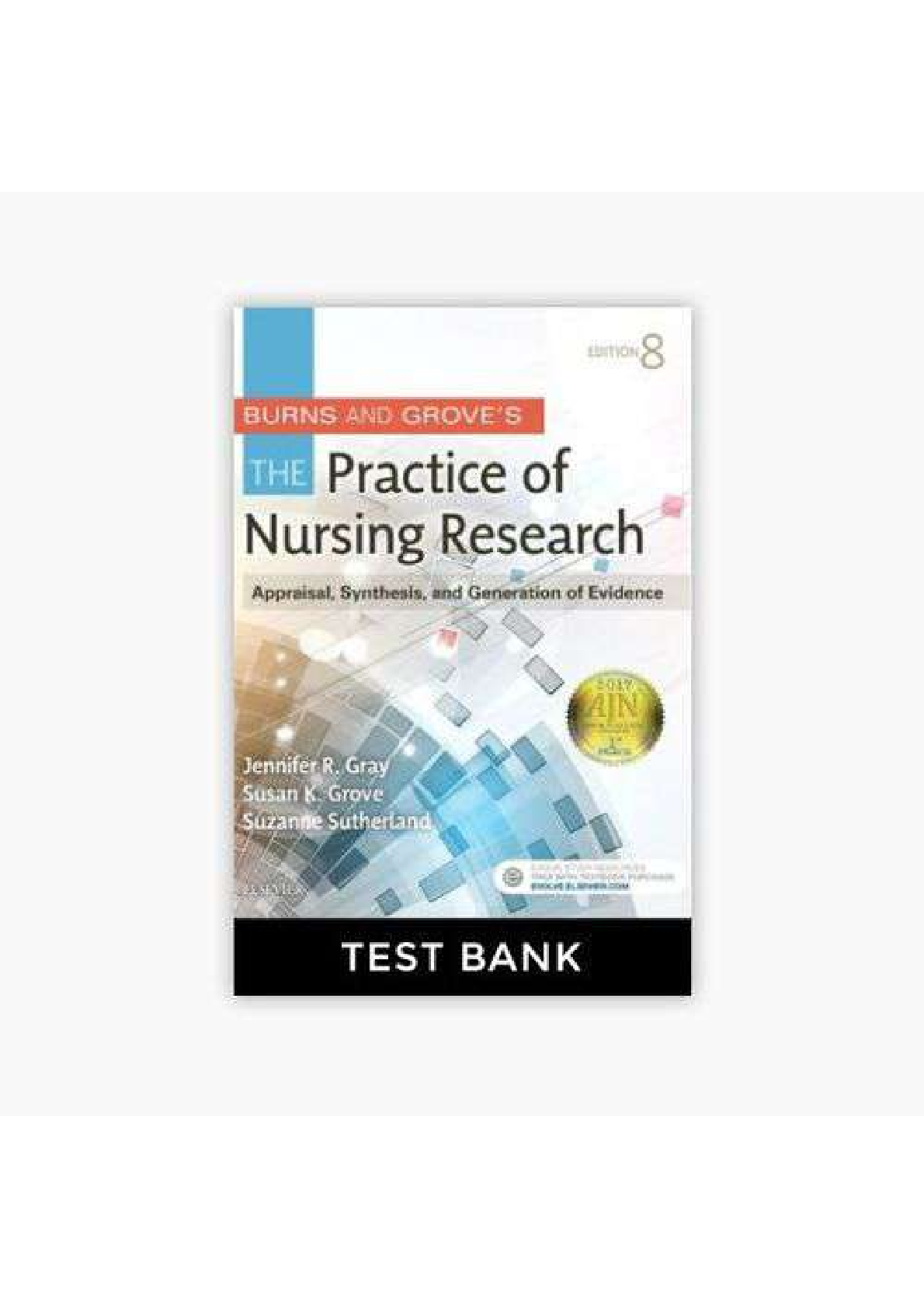
.png)

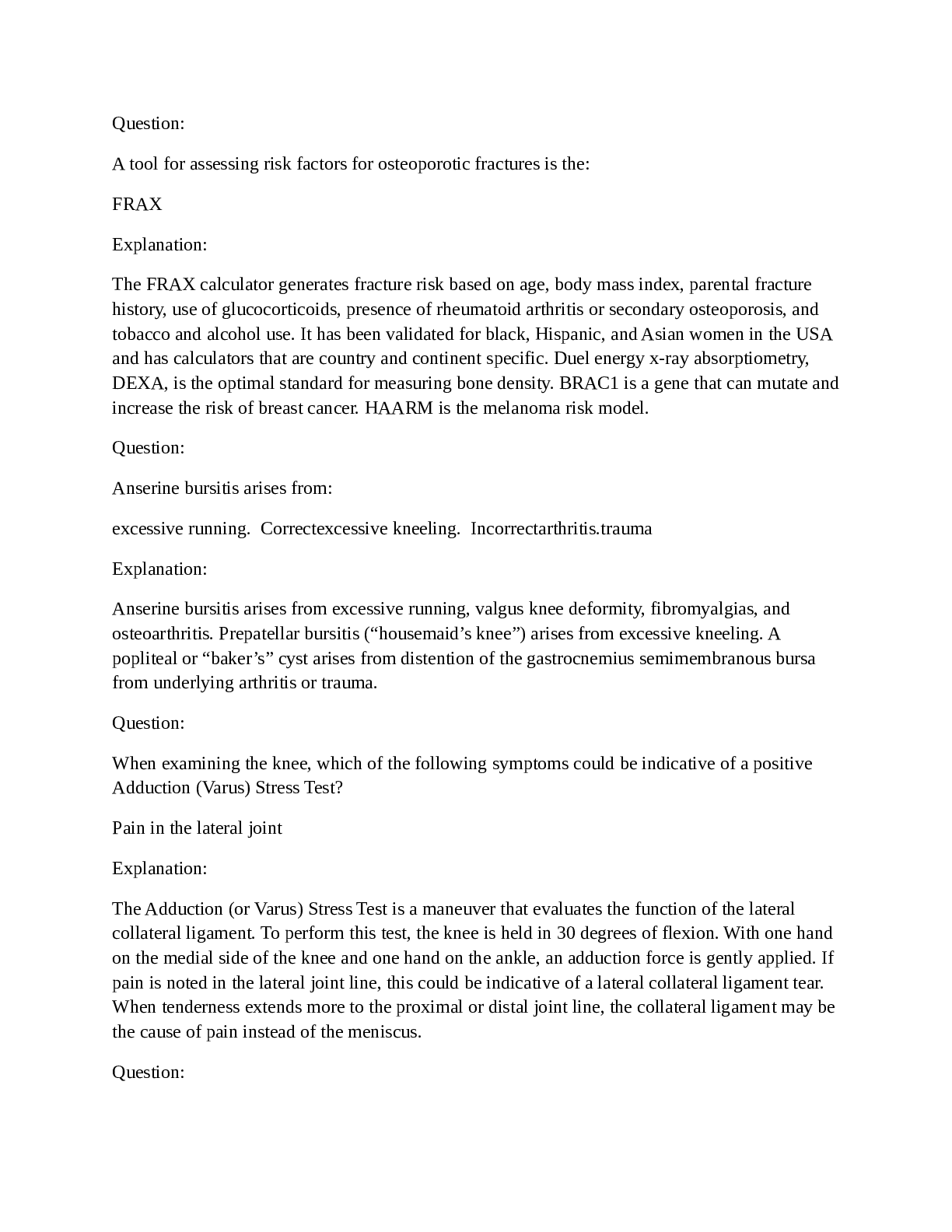

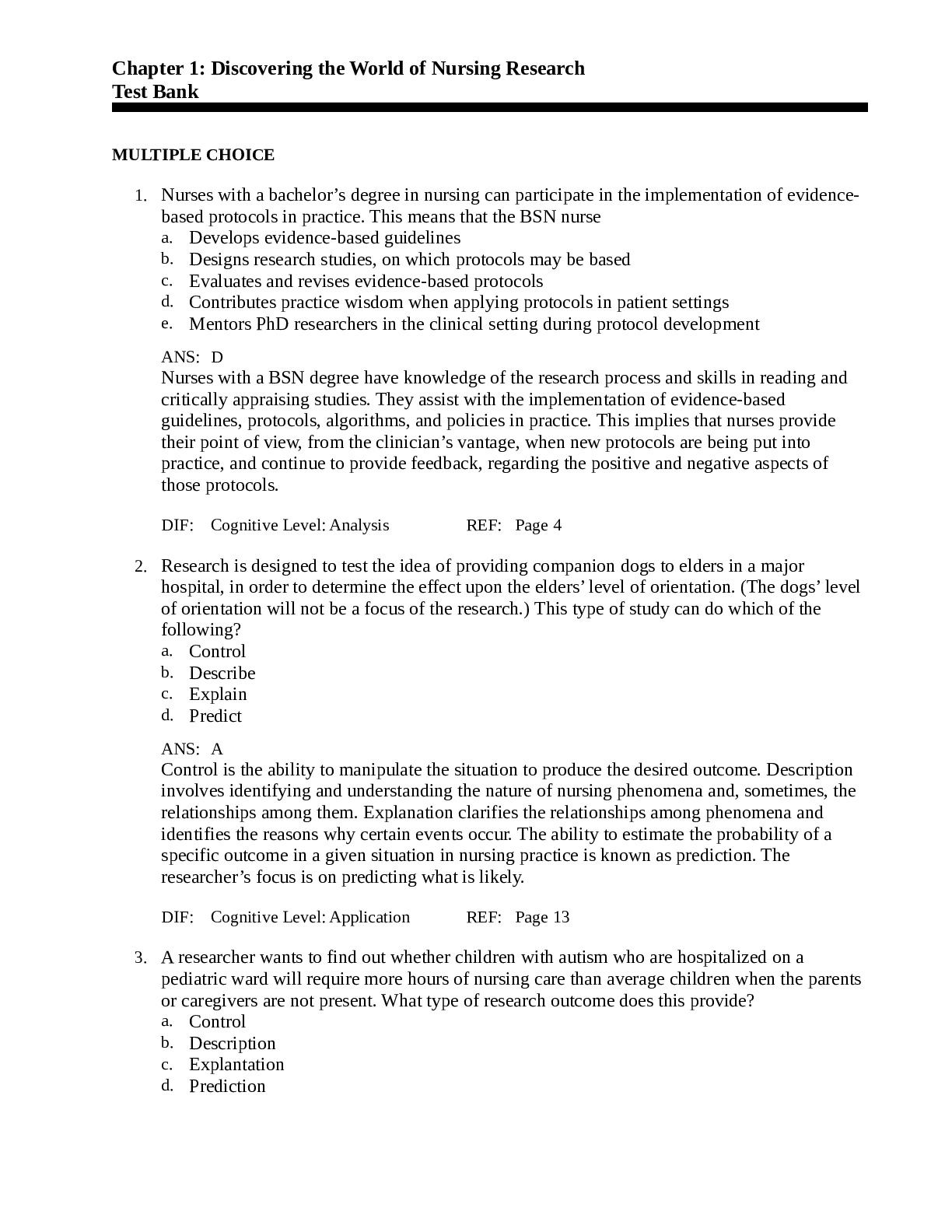
_removed.png)



